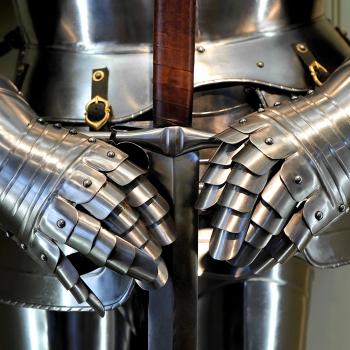To Train Up a Child, chapter 9, part 1
This chapter is titled Training Examples. It’s a longer chapter, so I’ll be going through it in several pieces. Because Michael’s stories can get repetitive, I’m going to try to draw a specific theme out of each section. For this section, I want to focus on the utter lack of any attempt to actually understand what is going on in the child’s head or the child’s needs, and the automatic interpreting of the child’s actions as “bullying”—even if the child is only trying to communicate a need.
STRIKING OUT
As my wife was counseling with a young mother, I watched a most amazing scene unfold. The first of two children (a two-year-old), upon failing to get attention, picked up a plastic toy wrench and began to pound his mother’s arm. Occasionally, he would reach up and poke her in the face. This was not new behavior. We had previously observed these “way of Cain” acts of violence perpetrated on the little brother as well as on the mother. On a previous day my wife observed him taking a tricycle wheel and slamming it down on his mother’s foot. She would cry out, “Johnny (The name has been changed to protect the guilty mother), that hurts Mother.” And, in a whining voice, “Don’t hurt your Mother.” Wham!! Down goes the tricycle wheel on her foot again. “Stop it, that hurts!” I’ll tell you what hurts. It hurts to see a mother abuse her child by doing nothing while her responses are making a criminal out of little Johnny.
My son Bobby sometimes attacks my laptop. He tries to push it shut when I’m trying to work on it, and believe me, it is quite annoying. But I know why he does it. He wants to get my attention. He’s one year old, and doesn’t know how to talk yet. My daughter Sally is several years older, and sometimes if I’m talking with someone else and she needs me or wants my attention she’ll stand by me saying “Mom! Mom! Mom!” and then eventually begin pulling on my clothing. This too is very annoying. But again, I understand why she does it. She is trying to get my attention. Too often adults view children as nuisances and ignore them when we should be listening—or interpret their actions as violent or “bratty” when they are simply trying to communicate with the only tools available to them.
 As a parent, it is crucial to consider your child’s perspective and look for the why behind her actions. I’m not saying Johnny’s mother should just let Johnny run over her foot with the tricycle, or that she should allow him to establish hitting her with toys as a positive way of getting her attention. But there are positive ways of dealing with these things that take the child’s needs and level of development into consideration. If it were Sally, I would explain that the given action was hurting me and teach her a more appropriate way to communicate her needs, thus establishing positive patterns that will help her throughout my her life. If it were Bobby, I would remove the offending object. Bobby is at the age where if he does something that hurts me and I yelp, he thinks it’s funny and tries it again—a result not of malice, but of his age.
As a parent, it is crucial to consider your child’s perspective and look for the why behind her actions. I’m not saying Johnny’s mother should just let Johnny run over her foot with the tricycle, or that she should allow him to establish hitting her with toys as a positive way of getting her attention. But there are positive ways of dealing with these things that take the child’s needs and level of development into consideration. If it were Sally, I would explain that the given action was hurting me and teach her a more appropriate way to communicate her needs, thus establishing positive patterns that will help her throughout my her life. If it were Bobby, I would remove the offending object. Bobby is at the age where if he does something that hurts me and I yelp, he thinks it’s funny and tries it again—a result not of malice, but of his age.
Children, especially small children, communicate with their parents in a variety of ways. Michael says that Johnny sometimes carries out “acts of violence” against his little brother. If Johnny is two and has a little brother, his brother is still a baby. It could be that Johnny sometimes hits him or bites his little brother because Johnny is jealous that his little brother has stolen the limelight—and it may be a sign that Johnny needs more attention and to know that he is still loved. This does not justify the actions. It does not mean they should be allowed to continue. But parenting works so much better if you try to understand your child’s needs and what they are trying to say rather than simply jumping to judgment.
And with that, we return to the text.
Well, on this occasion it would turn out differently. As the talk continued, little Johnny got tired of assaulting his mother and turned on my wife.
I want to pause to note that it most definitely sounds like Johnny was simply trying to get his mother’s attention—attention his mother refused to give him.
After the first blow, almost without diverting her eyes from the mother, and with no change of expression, she picked up a matching plastic toy. This was not to fight back, but to train. The mother is the one who would most benefit from what was about to occur. As little Johnny drove home the next blow, swiftly and with more than matching force, my wife struck. Such surprise! What is this little Johnny feels coming from his arm? Pain! And somehow it is associated with the striking of this toy. Again, Johnny strikes. Again, swift, retribution (training really). Johnny is very tough; so, though he didn’t cry, he pulled back his pained arm and examined it carefully. You could see the little mental computer working. As if to test his new theory, again, but with less force, he struck. The immediately returned blow was not diminished in strength. This time, I thought he would cry. No, after looking at his mother, as if to say, “What is this new thing?” he again, and with even less force, struck my wife on the arm. I was thinking, “She will lighten up this time and match his diminished intensity.” Again, my wife struck, seemingly, with all the force she could possibly muster without standing for a wind-up.
If your child is carrying out an action you do not consider acceptable, does it really make sense to respond with that same action? Doesn’t it make more sense to teach the appropriate action? Why could Debi not have taken this moment to teach Johnny a positive way to get his mother’s attention, and to remind Johnny’s mother of the importance of listening to her children and their needs?
Sure, it could be argued that Johnny didn’t realize that hitting someone with a toy would hurt, and that he needed to be shown that. That does not explain, though, the fact that even as Johnny decreased his blows Debi increased them until she struck him “with all the force she could possibly muster without standing for a wind-up”—far harder than Johnny ever hit. It’s also not a good idea even beside that. There are better ways to handle this. If a child that age is, say, hitting a baby, my response would be to take the child’s hand and use it to stroke the baby, saying “we be gentle with babies, gentle, like this.” The same is true for hitting a parent to get their attention. The solution should be to show the acceptable action, not to respond by repeating the unacceptable action back to the child.
Now you may wonder what the mother was doing all this time. Believe it or not, the two women had continued to talk, my wife, as if all was normal, the mother, with a facial expression divided between wonder and mild alarm. Johnny, tough enough for special forces, did one of those pained, crying faces covered by a forced smile. To my amazement, with one-fourth the original force, he again smack my wife. This time, her bottom came off the couch as she drew back to return the blow; and I heard a little karate like wheeze come from somewhere deep inside. I was hoping that Johnny was getting close to learning his lesson. The conversation had about died in anticipation of the outcome. Johnny must have had a Viking lineage, for he continued to trade blows about ten times. On Johnny’s part, the blows got lighter and lighter until, after a short contemplative delay, he gave a little tap that was returned with a swift, forceful blow. He let the toy wrench lay limp in his hand while he studied my wife’s face. I think he was puzzled by the relaxed non-threatening look. He was accustomed to being argued with and threatened. He had been trained to expect building antagonism to precede confrontation. My wife never even spoke to him, hardly looked at him, and gave a friendly smile when she did.
If there were an adult in my home who wound up and then hit my child so hard that he issued “a little karate like wheeze,” or who hit my child with a “swift, forceful blow” I would show her (or him) out immediately.
Well, he was a lot smarter than the cat who learned to keep his tail out from under the rocker. He turned away from my wife, shrugged his shoulders, bounced his legs, smiled, examined his arm and looked at the wrench still in his hand. I could see an idea come into his experimental little head. He turned to his mother and pounded her on the arm. As she rubbed her arm and cried, “Johnneeeee, that hurrrrt!” my wife handed the wrench to her. The next time Johnny smack, the young mother courageously returned the blow. It only took two or three times to learn his lesson for good. The mother was the one being taught. If she remained consistent, Johnny would be forever broken of a tendency to be a bully.
“Tendency to be a bully”? Really?
Oxford Dictionary: bully: a person who uses strength or power to harm or intimidate those who are weaker.
It’s true there is a bully in this story, but it’s not Johnny.
Understand, the adults’ use of the toy wrench was not a substitute for the rod. This was not discipline, but training. The child was cheerfully striking with the toy. Though frustrated, he was not angry or mean. Had that been the case, his medicine would have been the rod.
Debi says that Johnny was not “angry or mean.” How, then, did his reactions reflect a “tendency to be a bully”? If Debi could see that Johnny wasn’t angry or being mean, how could she not see that Johnny was almost certainly simply trying to get his mother’s attention? Is she incapable of interpreting a child’s self-assertion as anything but a bully in the making?
The returned blows were teaching him that what he was doing was painful and undesirable. He was also being taught that there were others who could give it out better than he. Most little bullies are cured by meeting a bigger bully. Children learn not to pick up wasps by picking up one.
. . . is this really how we want to be teaching our children?
What is hard for some to believe is that the results of that encounter endeared my wife to little Johnny. He seems to love her dearly and demands to be picked up when she is near. Children are comfortable around someone who has control of their own emotions, and with whom they know their limitations. Since this experience and further counseling, the mother and the child are showing great improvement.
Assuming this is true, it’s worth pointing out that Debi at least paid attention to Johnny. He was trying to get attention, and she gave him attention. His mother did not. But then, given Michael and Debi’s utter inability to understand what is actually going on inside of a child, I’m not sure I can trust his telling.
The line that keeps coming back to me here is “most little bullies are cured by meeting a bigger bully.” I think the point I want to make here will best be illustrated with a short story of my own. Sally sometimes has meltdowns. Most recently she completely lost it because I would not buy her everything she picked out in a store—I told her I would buy her only one thing, and that she had to choose. Sally was not okay with that, and began crying angrily, and becoming more nad more agitated. I got down on Sally’s level and spoke to her calmly.
“Sally, we cannot always buy everything we want,” I told her. “It’s hard, I know. But what we can control is how we respond to disappointment. Learning how to handle our emotions in a healthy way is an important adult skill, and it’s something you need to learn before you grow up.”
“But I have not learned that yet!” Sally cried out, distraught.
“Oh, honey, I know you haven’t.” I pulled her into my arms. “Here, cry on my shoulder. I know it’s hard. Sometimes I really want to buy everything too.”
Sally was still crying as we left the store, but her tears were gradually lessening. I suspect Michael (and Debi) would have interpreted Sally’s actions as her being a “bully,” trying to manipulate me into buying her everything she wanted. From reading Michael’s book, it’s pretty clear that his solution would have been for me to be a bigger bully in response—to “win” the battle between parent and child and to “conquer” the child, likely with the threat and application of the rod. But I don’t see Sally’s actions as those of a bully and I don’t see my relationship with her as a “battle” to be “won.” Parenting is, at its core, about preparing a child for adulthood—for the day when that child is on her own. Parenting should be about teaching children the skills they will need to live a healthy adult life—skills they are not born known. Parenting should never be about curing a little bully by being a bigger bully.














